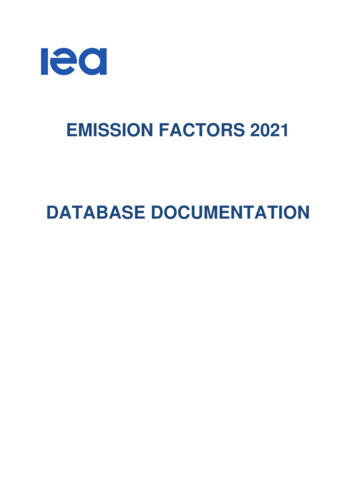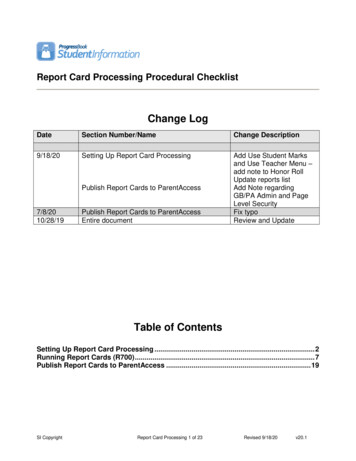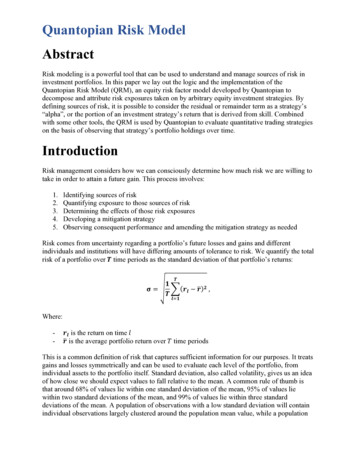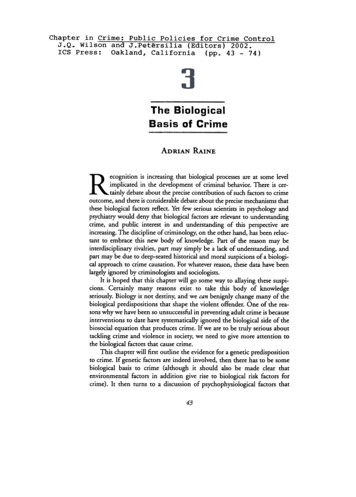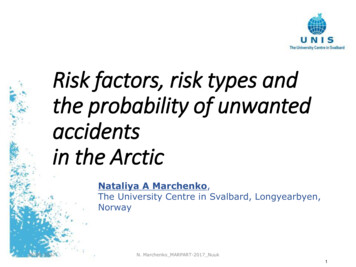
Transcription
Risk factors, risk types andthe probability of unwantedaccidentsin the ArcticNataliya A Marchenko,The University Centre in Svalbard, Longyearbyen,Norway29.08. 2017N. Marchenko MARPART-2017 Nuuk1
Navigation Safety andRisk Assessment Challengesin the High NorthNataliya A Marchenko,The University Centre in Svalbard, Longyearbyen, NorwayOdd J Borch and Natalia AndreassenThe University of Nordland, Bodø, Norway;Svetlana KuznetsovaNorthern (Arctic) Federal University, Arkhangelsk, RussiaValur IngimundarsonThe University of Iceland, Reykjavik, IcelandUffe JakobsenThe University of Copenhagen, Copenhagen, Denmark29.08. 2017N. Marchenko MARPART-2017 Nuuk2
MARPART project 2014-2017Work packages WP 1) Futuremaritime activitylevel and riskpatterns in the HighNorth Activity and probability of incidentsConsequences of different accidents Analyses of risk in different seaareas. Risk Matrix29.08. 2017N. Marchenko MARPART-2017 Nuuk WP 2) Institutionalframework, governance,resources andinstitutional strategieswithin different searegions WP 3) Organizationsand operationalmanagement structureslinking cooperatinginstitutions in jointmaritime operations3
Research area and partnersPartners:Advisory Boardgives the tasks and makesquality control29.08. 2017N. Marchenko MARPART-2017 Nuuk The University ofNordland University of Tromsø UNIS-The UniversityCenter of Svalbard The University ofGreenland The University ofIceland The Northern (Arctic)Federal University.Arkhangelsk, Russia MSTU -The MurmanskState TechnicalUniversity, Russia The Norwegian PoliceUniversity College The NorwegianDefence UniversityCollege4
MARPARTPUBLICATION - 201529.08. 2017N. Marchenko MARPART-2017 Nuuk5
MARPART PUBLICATION - 2016www.isope.orgProceedings of the Twenty-sixth (2016) International Ocean and Polar EngineeringConference Rhodes, Greece, June 26-July 1, 2016Copyright 2016 by the International Society of Offshore and PolarEngineers (ISOPE) ISBN 978-1-880653-88-3; ISSN 1098-6189Maritime Safety in The High North– Risk and PreparednessNataliya A. Marchenko1, Odd J. Borch2, Sergey V. Markov3, Natalia Andreassen21Department of Arctic Technology, the University Centre in Svalbard, Longyearbyen, Norway2Bodø Graduate School of Business, University of Nordland, Bodø, NorwayInstitute of Complex Safety, Northern (Arctic) Federal University named after M.V. Lomonosov, Arkhangelsk,Russiax3ABSTRACTIncreasing human activity in the Arctic creates great concern aboutpossible accidents and their consequences for life and nature. Thesufficient level of preparedness for emergency cases should be definedand secured. On the basis of previous assessment of activity level andrisk matrix and analysis of existing search and rescue resources, theestimation of preparedness system has been done. Three regions(mainland Norway, Svalbard area and Russian part of the Barents Sea)are under consideration and comparison. The international collaborationfor safety on the sea is very important in the border area.warming the development here, especially on Svalbard, will serve as amodel for other regions of the Arctic. The situation which we have nowon Svalbard (tourist vessel with 3000 passengers on 80 o N, forexample) can be repeated on Greenland, North of Canada or Franz JosefLand or Novaya Zemlya with characteristic problems. That’s why ourstudy can have global perspective and interest.KEY WORDS:maritime; safety; risk assessment; preparedness;Arctic; navigation; accident;INTRODUCTIONThe modern development of the Arctic creates a need for understandingof the risk factors, risk mitigating tools, and adequate rescue systemcapacities in the different area. Safe maritime operations in the HighNorth depend on the risk assessment, preparations and preparedness ofthe companies involved as well as the government. Activities in theArctic are challenged by limited infrastructure, long distances and harshweather conditions.The presented work is the part of MarPART (Maritime preparednessand International Collaboration in the High North) project, where theresearchers are responsible for safety organizations of all the countriesof Atlantic Sector of the Arctic on the base of activity and riskestimation should find the way of cross-institutional and cross-countrypartnership (Nord Universitet, 2016). That is especially important onHigh North with rare population and limited rescueresources.Activity and probability of accidents differ in various parts of theArctic, due to geographical, economic and historicalreasons.In this study, we focus in particular on 3 regions: Norwegian areasaround Svalbard, along the coast of mainland Norway and on WestRussian Arctic in the Barents Sea up to Novaya Zemlya (Fig.1). Thissector creates the gateway to the Arctic and in the case of global29.08. 2017N. Marchenko MARPART-2017 NuukFigure 1. Three regions under consideration. Base map is “Norwegianrescue service's area of responsibility” (red lines) (BarentsWatch, 2013).Key ports and rescue centers are shownThe paper aims to analyze the rescue system resource capacities. It isnecessary to discuss the preparedness system considering the volatileenvironment, activity levels and risk assessments done for these three6
Presentation and paper on TransNAV 2017conferenceREGIONS OF THEATLANTIC ARCTIC andco-authorsCreated on the base of ArcticSearch and Rescue AgreementMap (Arctic Council 2011).29.08. 20171-Greenland - Uffe JakobsenThe University of Copenhagen,Denmark2-Iceland - Valur IngimundarsonThe University of Iceland, Reykjavik,3-Svalbard - Nataliya A Marchenko,The University Centre in Svalbard,Longyearbyen, Norway4-Coastal Norway - Odd J Borchand Natalia AndreassenThe University of Nordland, Bodø,Norway;5-Russian sector of the Barents Sea Svetlana KuznetsovaNorthern (Arctic) Federal University,Arkhangelsk, RussiaN. Marchenko MARPART-2017 Nuuk7
TRANSNAV conferenceTransNAV family29.08. 2017TransNAV journalN. Marchenko MARPART-2017 Nuuk8
OUR TransNAV papersProceedings: Navigation Safety and RiskAssessment Challenges in the High NorthJournal: High-risk emergencies in the Arctic seas: assessmentand response capacities29.08. 2017N. Marchenko MARPART-2017 Nuuk9
MARITIME ACTIVITY PATTERNType of vessels coming to ArcticPorts. Created on the base of(Norwegian Coastal Administration2017)29.08. 2017Number of port callsdynamicsN. Marchenko MARPART-2017 Nuuk10
MARITIME ACTIVITY PATTERNTypes of crossing conventional linesvessels (data from the Arctic Havbase(Norwegian Coastal Administration2017). Red numbers – line number(see fig. 4). Blue numbers- totalnumbers of passengers in onedirection.29.08. 2017Number of passengerscrossing conventional lines(data from (NorwegianCoastal Administration 2017)N. Marchenko MARPART-2017 Nuuk11
RISK ASSESSMENT THEORY.2 APPROACHES AND EXAMPLESThe risk is then the product of the probability that an accident happensmultiplied by the severity of that harm. In practice, the risk level isusually given a coarse-grained categorization, because neither theprobability nor the harm severity can be estimated with accuracy andprecision. Some accident types such as violent action and terror havenot yet happened, but may occur also in this region.LOCAL,SPECIFIED29.08. 2017REGIONAL,UNIFIEDN. Marchenko MARPART-2017 Nuuk12
Canadian Arctic Shipping RiskAssessment System (CASRAS)Route navigability using the PolarOperational Limit Assessment RiskIndexing System (POLARIS) for a PC6vessel, according to the observed iceconditions on March 14, 2016. Yellowand orange zone require limiting speedand escorting.Ivana Kubat, Lawrence Charlebois, RichardBurcher, Philippe Lamontagne, David WatsonNational Research Council of Canada, Ottawa,Canada)Paper -133.Proceedings of the 24thInternational Conference onPort and Ocean Engineering under ArcticConditionsJune 11-16, 2017, Busan, Korea29.08. 2017N. Marchenko MARPART-2017 Nuuk13
Environmental Risk connected topotencial oil polution fromshiptraffic i Sea areas aroundSvalbard and Jan Mayen“Miljørisiko knyttet til potensiell akuttoljeforurensning fra skipstrafikk i havområdeneomkring Svalbard og Jan Mayen”Ice concentrationmore than 70%DNV GL – Norwegian coastAdministration, 201429.08. 2017N. Marchenko MARPART-2017 Nuuk14
REGIONAL UNIFIED Risk analyses.Possible variation of accidents, depending ofship type and eventsTourist/Crui Cargo/tanker/ Fishingse ingDamage due to collision(sea ice and other)FireViolence/terrorOther reasonsT-FT-VT-OC-FC-VC-OF-FF-VF-OData/ materials used:Risk assessments by DNV GL (Paaske et al., 2014) (DNV GL, 2014c, DNV GL, 2014a);the SADA report by Steipen et al. (Stepien et al., 2014);the AMSA report (Arctic Council, 2009);the National Risk Analysis by DSB (Norwegian Directorate for civil Protection (DSB), 2013)incidents statistics 2013 of Norwegian Maritime Authority (www.sjofartsdir.no).For the Svalbard area, an overview of Longyearbyen port current and planned activities (Multiconsult, 2014)risk analysis performed by Governor of Svalbard on 2013 (Sysselmannen på Svalbard, 2013).29.08. 2017N. Marchenko MARPART-2017 Nuuk15
8. 2017Ship traffic pattern. 2012cargo (refrigerator – green;general – blue), tankers (red)and supply vessels (orange)fishing (yellow),passenger ship (bright blue)and the others (white).http://www.arkgis.org/N. Marchenko MARPART-2017 Nuuk16
7Activity level factorsEconomicUnprofitable,New technologyPolitic?NatureWarm, openN. Marchenko MARPART-2017 Nuuk17
Search and Rescue Operations29.08. 2017N. Marchenko MARPART-2017 Nuuk18
Ship Accidents in Svalbard area220 km430 km29.08. 2017N. Marchenko MARPART-2017 Nuuk19
Recent accidents. 20163-5.06.2016. Governor tows vessel Ortelius with 146people back to Longyearbyen after engine failure.September 2016Noorderlihtch grounded29.08. 201723.06.2016 . Polarcircle took in water after collision withIce. 2 persons were picked up by k-inn-vann/19.7313N. Marchenko MARPART-2017 Nuuk20
Recent accidents. 2017January 2017UNIS boat with 12 people.-20 o C, took in water and both enginesstopped.LongyearbyenJuly 2017 . Langøysund20.07- Motor stopped. 28.07 Fire.Longyearbyen29.08. 2017N. Marchenko MARPART-2017 brannen/19.8728
Risk Matrix. Svalbard areaRisk matrix of consequences for environmentRisk matrix of consequences for people (passengers, crew)red area symbols high risk,29.08. 2017yellow – modern,N. Marchenko MARPART-2017 Nuukgreen – low.22
Risk Matrix. Greenlandic watersRisk matrix of consequences for environmentRisk matrix of consequences for people (passengers, crew)29.08. 2017N. Marchenko MARPART-2017 Nuuk23
Risk Matrix. Icelandic watersRisk matrix of consequences for environmentRisk matrix of consequences for people (passengers, crew)29.08. 2017N. Marchenko MARPART-2017 Nuuk24
Risk Matrix. Coastal Norway8. 2017Risk matrix of consequences for environmentRisk matrix of consequences for peoplered area symbols high risk,yellow – modern,N. Marchenko MARPART-2017 Nuukgreen – low.25
Risk matrix.Russian part of Barents SeaRisk matrix of consequences for environmentRisk matrix of consequences for peoplered area symbols high risk,yellow – modern,N. Marchenko MARPART-2017 Nuukgreen – low.26
Type of events of different risk level (red - high,yellow – moderate, green – low) for 2 regionsunder consideration29.08. 2017N. Marchenko MARPART-2017 Nuuk27
Share of events with different risk levelin the regionsRisk Matrix. Svalbard areaconsequences for environmentconsequences for people29.08. 2017N. Marchenko MARPART-2017 Nuuk28
AcknowlegementMARPART projectColleagues at UNISInterview with capitain of Arctic Umiaqline ship “Safraq Ittuk” Poul Krogsgaard(more than 20 years experience)Thank you for your attention29.08. 2017N. Marchenko MARPART-2017 Nuuk29
The University of Copenhagen, Denmark 2-Iceland - Valur Ingimundarson The University of Iceland, Reykjavik, 3-Svalbard - Nataliya A Marchenko, The University Centre in Svalbard, Longyearbyen, Norway 4-Coastal Norway - Odd J Borch and Natalia Andreassen The University of Nordland, Bodø, Norway; 5-Russian sector of the Barents Sea - Svetlana .





